
Create a Floral Paradise in Your Garden
Create a Floral Paradise in Your Garden With These PlantsWe’ve heard from a little birdie that you’re in need of some more flowers in the

Today I was going to talk about horticulture as an art form. The mission of Hello Hello is to make the beauty of horticulture accessible to millions of people. We do this by having an extensive website, by putting out reliable information on our socials, and by having a nursery with a huge range of beautiful plants.
You can’t see me through this page, but right now I’m in the receivables area, looking at what new stock that has come in for the Labour Weekend onwards. If you want a visual of what I’m talking about, just hop on over to our Facebook Page (links below) where you can watch this. I’d love to show you some of these plants and talk through the art of horticulture, in a way that even the most anti-green thumb can understand.
You walk into a nursery, and you see all these bushy, green, lively looking plants. But you don’t really know a whole lot about it – what soil type it needs, what type of climate it thrives in. Building your dream garden is actually a much more daunting task than it seems. Which is why I’m going to go through some of the new plants coming in so that you can be ready for this weekend.
Now I’ve worked in the industry for many decades, but I still come across plants I haven’t seen before. Such as the Melaleuca. A lot of Melaleucas grow really big, I’m talking ten metres tall and eight metres wide, and are very bushy. But this one here just grows a couple metres tall, and a metre or two wide. It’s a lovely bright green plant and it would be really good in landscapes. Also it’s very hardy, doesn’t need much water and can handle a lot of wind and poor soil conditions.
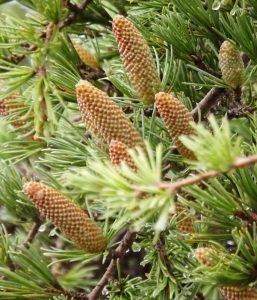 So my dad was also in the horticulture field, and he brought all us kids into it. My siblings and I would go up to Lancefield and harvest the cones off of Indian Cedars. Then we would bring them back and warm them in this big boiler so that they would fall apart, and we could get the seeds inside. My dad would plant the seeds in a little pot and after about three years we’d get a little Indian Cedar. Incredible, isn’t it? That wasn’t the only Cedar we harvested, in Mount Dandenong there is a Blue Cedar that we would cut the shoots off of and then my dad would graft them. He would seal them up with a bit of plastic and tar and then grow them.
So my dad was also in the horticulture field, and he brought all us kids into it. My siblings and I would go up to Lancefield and harvest the cones off of Indian Cedars. Then we would bring them back and warm them in this big boiler so that they would fall apart, and we could get the seeds inside. My dad would plant the seeds in a little pot and after about three years we’d get a little Indian Cedar. Incredible, isn’t it? That wasn’t the only Cedar we harvested, in Mount Dandenong there is a Blue Cedar that we would cut the shoots off of and then my dad would graft them. He would seal them up with a bit of plastic and tar and then grow them.
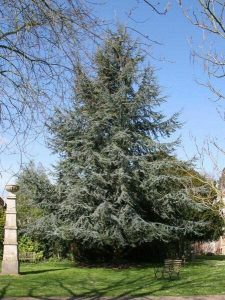 Nowadays the growing process of a Blue Cedar is a bit more complicated. You’ll have one guy that grows thousands of seeds that he’ll then sell to another bloke that will graft them and put them in pots for a year or two. Then that bloke will sell them to somebody else that grows them for another year or two. So it’s a lot of time and effort to grow a Blue Cedar and it requires a great amount of skill. The one we have here is five foot tall for $149.99, which is a pretty incredible price when you think of all the time and effort that went into it. If you are doing a classic or traditional style garden, a Blue Cedar would be the perfect addition.
Nowadays the growing process of a Blue Cedar is a bit more complicated. You’ll have one guy that grows thousands of seeds that he’ll then sell to another bloke that will graft them and put them in pots for a year or two. Then that bloke will sell them to somebody else that grows them for another year or two. So it’s a lot of time and effort to grow a Blue Cedar and it requires a great amount of skill. The one we have here is five foot tall for $149.99, which is a pretty incredible price when you think of all the time and effort that went into it. If you are doing a classic or traditional style garden, a Blue Cedar would be the perfect addition.
Now I’m going to show you something that you would never have seen before. It’s called Peria, a Purple Weeping Birch. This is a ground covering Japanese Willow that has been grafted onto a French Pussy Willow and then trimmed up and grown for about two more years in a pot. It’s a really hardy plant, particularly great if you have a boggy or windy spot. But it still has a beautiful fine foliage that is a gorgeous blue-green shade. When you look at a tree you probably never think about how many people and how much time was put into creating it. Our Peria here is a five-year-old tree and there is a real artistry and skill behind its creation, you could go to 60 other nurseries and not find one of these. In the horticulture industry there’s all these different people doing different things, and it’s really just quite incredible.
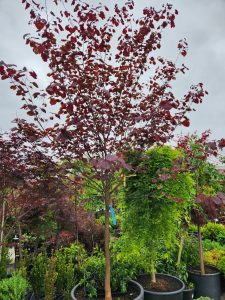 Next, we have the Forest Pansy, another grafted tree. What they do is, they get a normal green surface that has pink flowers and then graft a purple one onto it. Now this Forest Pansy has stunning purple leaves throughout summer and autumn and in spring it will have pink blossoms. What a show of colour! It truly is a work of art. But quite difficult to do. To get it to the size that you can graft it takes about two years, and then to get it to a decent size takes another two or three years. Also there isn’t a super high success rate when it comes to grafting these, you really have to know what you’re doing.
Next, we have the Forest Pansy, another grafted tree. What they do is, they get a normal green surface that has pink flowers and then graft a purple one onto it. Now this Forest Pansy has stunning purple leaves throughout summer and autumn and in spring it will have pink blossoms. What a show of colour! It truly is a work of art. But quite difficult to do. To get it to the size that you can graft it takes about two years, and then to get it to a decent size takes another two or three years. Also there isn’t a super high success rate when it comes to grafting these, you really have to know what you’re doing.
Now this is a plant I only saw last week for the first time, it’s a Ginkgo Biloba American Standard. A lot of people love Ginkgos and it’s easy to see why. They have beautiful autumn colour, lush foliage and leaves that can be used as a herb. They also tend to be quite big. Now a Ginkgo Biloba American Standard is actually a miniature Ginko and it’s also a grafted plant. So it’s been grown from seed, grafted, and then grown for another few years. Most people are too frightened to put a Gingko in their garden because it might end up too big. Which is why this Gingko Biloba American Standard is so good because it’s compact and you could grow it on a balcony or in a small garden. It would never get too big.
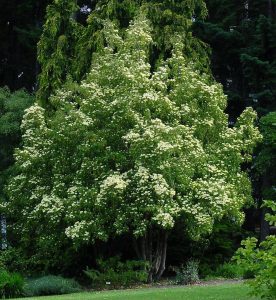 Also we’ve got a really rare Dogwood coming in and it’s called Cornus Capitata. It’s an evergreen with these beautiful big pink flowers which bloom right around Christmas time. Normal Dogwoods are a bit hard to grow, they can be quite slow and fussy. But the Cornus Capitata will grow in any soil. We got another really cool type of Dogwood coming in, called the Eric Gennet. It’s the best flowering Dogwood I’ve ever seen, even better than the Cornus Capitata. The flowers are this creamy colour with little hints of pink, just absolutely stunning. Not to mention the other types of Dogwoods we’re bringing in, like the Dogwoods with yellow stems or the ones that have red stems in the winter. If you’re interested in Dogwoods than it’s a great weekend to come in.
Also we’ve got a really rare Dogwood coming in and it’s called Cornus Capitata. It’s an evergreen with these beautiful big pink flowers which bloom right around Christmas time. Normal Dogwoods are a bit hard to grow, they can be quite slow and fussy. But the Cornus Capitata will grow in any soil. We got another really cool type of Dogwood coming in, called the Eric Gennet. It’s the best flowering Dogwood I’ve ever seen, even better than the Cornus Capitata. The flowers are this creamy colour with little hints of pink, just absolutely stunning. Not to mention the other types of Dogwoods we’re bringing in, like the Dogwoods with yellow stems or the ones that have red stems in the winter. If you’re interested in Dogwoods than it’s a great weekend to come in.
Beyond Dogwoods, we have so many interesting plants brought in to our nursery recently. It’s the perfect time to visit and see the artistry of horticulture. Come down and enjoy yourself and indulge in that dream garden vision of yours.
 As always, we have a little Q&A Section where we answer some of the questions that popped up. If you have any questions of your own come to our Facebook Live, it happens every week on Wednesday, and we cover a different topic every time. Here this week’s question:
As always, we have a little Q&A Section where we answer some of the questions that popped up. If you have any questions of your own come to our Facebook Live, it happens every week on Wednesday, and we cover a different topic every time. Here this week’s question:
Q. Burnett: What would you recommend to plant between fence and driveways? I have about a 10-15 centimetres gap.
A. Chris: Chinese Star Jasmine, Boston Ivy, or Ficus Pumila are all very good options. All of them could be grown up to cover the fence. The Chinese star and Jasmine need some trellis or wire or something to grow. But the Boston Ivy and Ficus Pumila will just stick on the fence and grow on the fence.
Well, there you have it, Horticulture as an art form. I hope you enjoyed today’s topic and don’t hesitate to reach out if you have any more questions.
Chris

Feeling inspired to create your own garden, but want some expert advice? Try our one-on-one garden design service with Chris. Together you’ll come up with a selection of plants along with a layout plan that gives you the look you want, as well as being suitable for your local soil and conditions.

Create a Floral Paradise in Your Garden With These PlantsWe’ve heard from a little birdie that you’re in need of some more flowers in the
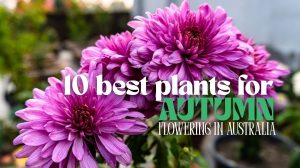
We all know about beautiful autumn foliage, the fiery reds, deep purples, striking golds and vibrant oranges. We’ve written extensively about these plants, from the

We live in Australia, it only makes sense that we should be planting Australian native plants. But for most people, they think Native Garden, and

Weekly specials, plus buy in bulk and save more.

Trade discounts & plant substitution advice.

Sourcing from over 150 growers Australia wide.

Decades of experience within our team.

Melbourne metro and regional Victoria.
Copyright 2025
No products in the cart.

